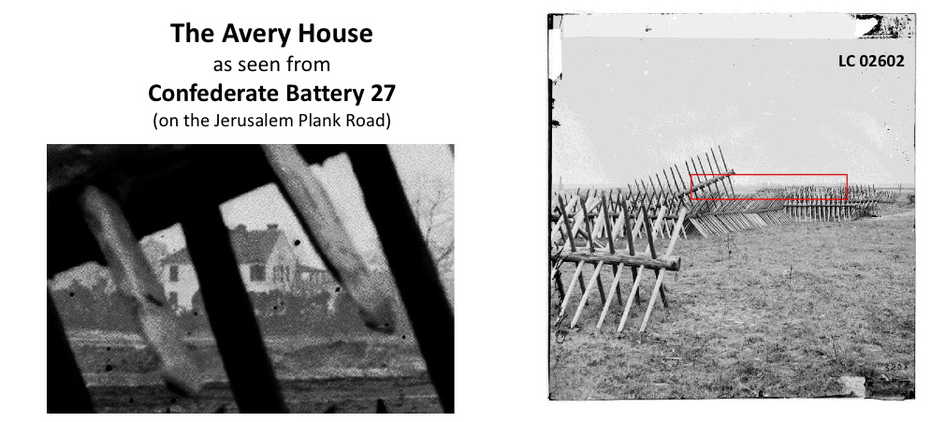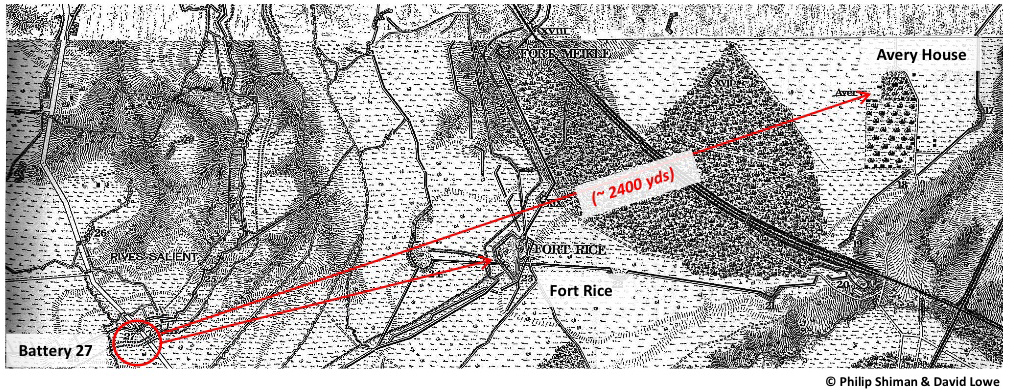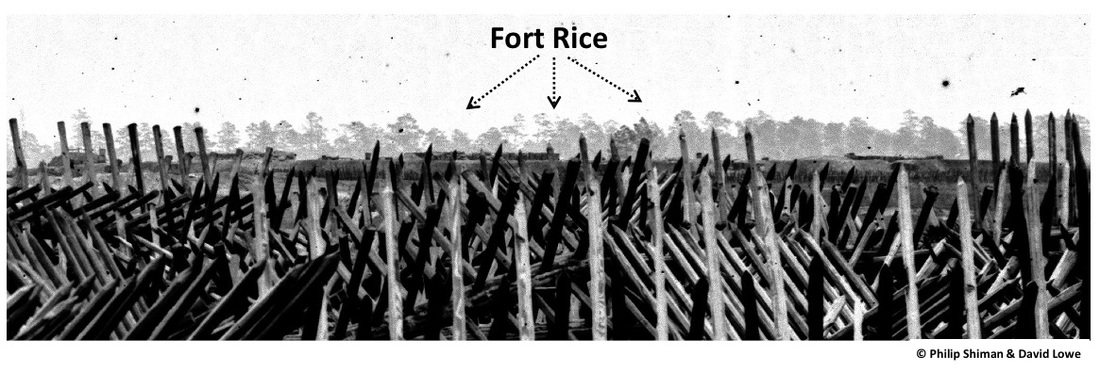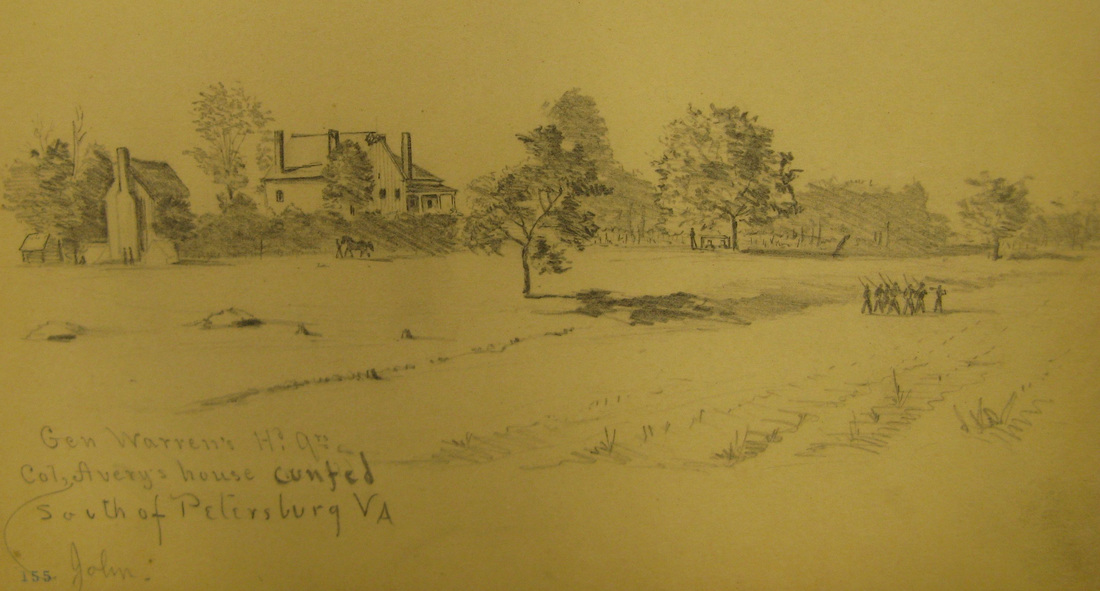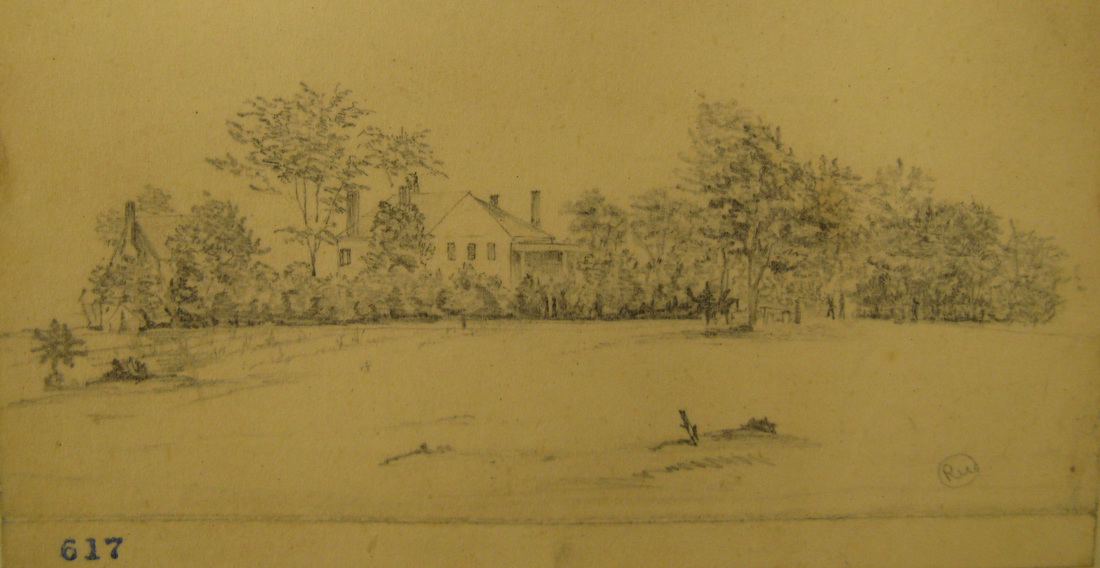“Avery Mansion.—Corps Headquarters.
Through the close proximity of all the officers and men to the corps General and staff, his orders are given immediate attention, and distributed to the division and brigade commanders of the corps without delay. The right arm of the corps General, at his headquarters, is called the Assistant Adjutant-General of the corps, with the rank of Colonel. He is furnished two assistants with the rank of Captain, and also a number of enlisted men detailed to assist in copying orders and preserving records, and tabulating morning reports and other routine work. It is through the Adjutant-General of the corps that all executive work and details of the corps, as planned and directed by the corps commander, are shaped and formulated for action and communication to all subordinate division commanders. Really, though usually but little seen or known to the public, the corps Adjutant-General is a most responsible officer, his office demanding constant «nergy in the discharge of the duties in active campaigning. The Fifth Corps was most fortunate in having, during the three years' service of the One Hundred and Fifty-fifth Regiment in the field, the duties of Assistant Adjutant-General, performed by Colonel Fred T. Locke, of New York, who was wounded in action several times, and on special recommendation of General Meade, was brevetted Brigadier-General for gallantry and meritorious services in the field.
The location of corps headquarters in the early days of the siege of Petersburg in the Avery Mansion was a source of no little concern to the large colony to be described below as comprising the headquarters. The shelling by the enemy, the Union mortar firing and Confederate replies, made the locality and building most undesirable, especially at night, when coveting tired nature's sweet restorer. General Warren and his personal staff preferred the beautiful lawn, and erected their tents on that ground. This left the stately mansion for the United States Military Telegraph operators, the Signal Corps and other departments. The upper stories were reserved for sleeping apartments, the accommodations being limited to sleeping on uncarpeted floors. During the first days of the siege, both armies were hard at work strengthening positions and extending their defenses, working at night as well as all day, in regular relief working parties.
On account of his reputation as a military engineer, General Warren, as corps commander, was, with the rank and file, kept unusually busy day and night in the great work of investing the Confederate army intrenched behind the miles of breastworks composing the defenses of Petersburg. In addition to the military fire-arms, the troops of this corps were furnished picks, shovels and spades and other tools, and were required day and night to serve on details for fatigue duty, as the hard labor in erecting forts and digging trenches, was termed. This work of the troops was done under frequent fire of the enemy, and the mechanical implements of the soldier-laborer had frequently to be dropped for the gun and its deadly sharpshooting.
General Warren, in directing and superintending with engineers this construction of siege operations, usually located corps headquarters close to the front, and in the vicinity of the siege works being constructed. A fine Old colonial mansion, known as the Avery Mansion, situated near the Union firing line on the 18th of June, on the great charge, had been abandoned by its owners. It was, notwithstanding its continued exposed condition, taken possession of as Fifth corps headquarters, and continued to be occupied as such during the first month of the siege. It had been already damaged in actions before its spacious parlors, rooms and grounds were made corps headquarters. The latter means in active campaigning much more than the corps General and his personal staff. Headquarters comprises, in addition, a large retinue of commissioned officers, such as corps Quartermaster, corps Commissary, corps Provost Guard, corps Medical Director, a company of sharpshooters, a company of cavalry as escorts, a number of mounted and unmounted orderlies, soldier clerks, United States Military Telegraph operators. United States Signal Corps. United States mail clerks, wagoners, teamsters and colored cooks and servants, in all forming a colony of from three to four hundred people, together with horses, mules, etc., all camped close together at the end of each night march, or in winter quarters. Also the medical, hospital and ambulance officers and new men formed quite a large contingent.
It did seem unkind and even malicious in both armies during this strenuous period of the siege, that every night just as the wearied day fatigue parties and the occupants of the Corps headquarters mansion were seeking sorely-needed rest, that the Confederate and Union batteries should at intervals break out in duels lasting often an hour or more. Stray shells and spent cannon balls frequently added to the excitement by striking the old Avery Mansion, penetrating the roof or a window with a great noise, and arousing the slumberers and especially terrifying the contraband cooks and servants in the corps colony. The United States Military Telegraph Corps operators had their ticking machines on the first floor of the building destroyed by one of these unwelcome visitors. The heavy siege mortars introduced by General Warren to the grounds of the Avery Mansion, when discharged at the enemy, as was done daily, also jarred and racked the venerable mansion, adding to the discomforts of the inmates. However, but few casualties resulted from the fire of the Confederates during this period of Corps headquarters.”
155th Pennsylvania Regiment, Under the Maltese Cross, 305-306
Through the close proximity of all the officers and men to the corps General and staff, his orders are given immediate attention, and distributed to the division and brigade commanders of the corps without delay. The right arm of the corps General, at his headquarters, is called the Assistant Adjutant-General of the corps, with the rank of Colonel. He is furnished two assistants with the rank of Captain, and also a number of enlisted men detailed to assist in copying orders and preserving records, and tabulating morning reports and other routine work. It is through the Adjutant-General of the corps that all executive work and details of the corps, as planned and directed by the corps commander, are shaped and formulated for action and communication to all subordinate division commanders. Really, though usually but little seen or known to the public, the corps Adjutant-General is a most responsible officer, his office demanding constant «nergy in the discharge of the duties in active campaigning. The Fifth Corps was most fortunate in having, during the three years' service of the One Hundred and Fifty-fifth Regiment in the field, the duties of Assistant Adjutant-General, performed by Colonel Fred T. Locke, of New York, who was wounded in action several times, and on special recommendation of General Meade, was brevetted Brigadier-General for gallantry and meritorious services in the field.
The location of corps headquarters in the early days of the siege of Petersburg in the Avery Mansion was a source of no little concern to the large colony to be described below as comprising the headquarters. The shelling by the enemy, the Union mortar firing and Confederate replies, made the locality and building most undesirable, especially at night, when coveting tired nature's sweet restorer. General Warren and his personal staff preferred the beautiful lawn, and erected their tents on that ground. This left the stately mansion for the United States Military Telegraph operators, the Signal Corps and other departments. The upper stories were reserved for sleeping apartments, the accommodations being limited to sleeping on uncarpeted floors. During the first days of the siege, both armies were hard at work strengthening positions and extending their defenses, working at night as well as all day, in regular relief working parties.
On account of his reputation as a military engineer, General Warren, as corps commander, was, with the rank and file, kept unusually busy day and night in the great work of investing the Confederate army intrenched behind the miles of breastworks composing the defenses of Petersburg. In addition to the military fire-arms, the troops of this corps were furnished picks, shovels and spades and other tools, and were required day and night to serve on details for fatigue duty, as the hard labor in erecting forts and digging trenches, was termed. This work of the troops was done under frequent fire of the enemy, and the mechanical implements of the soldier-laborer had frequently to be dropped for the gun and its deadly sharpshooting.
General Warren, in directing and superintending with engineers this construction of siege operations, usually located corps headquarters close to the front, and in the vicinity of the siege works being constructed. A fine Old colonial mansion, known as the Avery Mansion, situated near the Union firing line on the 18th of June, on the great charge, had been abandoned by its owners. It was, notwithstanding its continued exposed condition, taken possession of as Fifth corps headquarters, and continued to be occupied as such during the first month of the siege. It had been already damaged in actions before its spacious parlors, rooms and grounds were made corps headquarters. The latter means in active campaigning much more than the corps General and his personal staff. Headquarters comprises, in addition, a large retinue of commissioned officers, such as corps Quartermaster, corps Commissary, corps Provost Guard, corps Medical Director, a company of sharpshooters, a company of cavalry as escorts, a number of mounted and unmounted orderlies, soldier clerks, United States Military Telegraph operators. United States Signal Corps. United States mail clerks, wagoners, teamsters and colored cooks and servants, in all forming a colony of from three to four hundred people, together with horses, mules, etc., all camped close together at the end of each night march, or in winter quarters. Also the medical, hospital and ambulance officers and new men formed quite a large contingent.
It did seem unkind and even malicious in both armies during this strenuous period of the siege, that every night just as the wearied day fatigue parties and the occupants of the Corps headquarters mansion were seeking sorely-needed rest, that the Confederate and Union batteries should at intervals break out in duels lasting often an hour or more. Stray shells and spent cannon balls frequently added to the excitement by striking the old Avery Mansion, penetrating the roof or a window with a great noise, and arousing the slumberers and especially terrifying the contraband cooks and servants in the corps colony. The United States Military Telegraph Corps operators had their ticking machines on the first floor of the building destroyed by one of these unwelcome visitors. The heavy siege mortars introduced by General Warren to the grounds of the Avery Mansion, when discharged at the enemy, as was done daily, also jarred and racked the venerable mansion, adding to the discomforts of the inmates. However, but few casualties resulted from the fire of the Confederates during this period of Corps headquarters.”
155th Pennsylvania Regiment, Under the Maltese Cross, 305-306
The Avery House
"And at the Avery house, a residence of about the same length of time resulted in the same experience, although this house was less prominent. In October the enemy placed in barbette an 8-inch Columbiad directly opposite this house under the cover of darkness, but kept it there only three days, during which it was fired but once or twice. The first shell thrown from it fell directly in the door-yard in front of the house and by a piece of good fortune failed to explode.”
William R. Driver, "Siege of Petersburg After the Capture of the Weldon Railroad," in Papers of the Military Historical Society of Massachusets, vol. 5 (1906), 312-313
William R. Driver, "Siege of Petersburg After the Capture of the Weldon Railroad," in Papers of the Military Historical Society of Massachusets, vol. 5 (1906), 312-313
... and now we are up to the second line of works, they are silent and empty, and Gen. Hartranft, commanding the 3d Division of our Corps, jumps astride of the 8-inch Columbiad, which, a week or two before, had shelled his headquarters in the Avery House, and which he had sworn he would " straddle."
Source: R.C. Eden The Sword and the Gun. A History of the 37th Wisc. Volunteer Infantry, 1865, page 50. https://archive.org/stream/01666961.3303.emory.edu/01666961_3303#page/n5/mode/2up
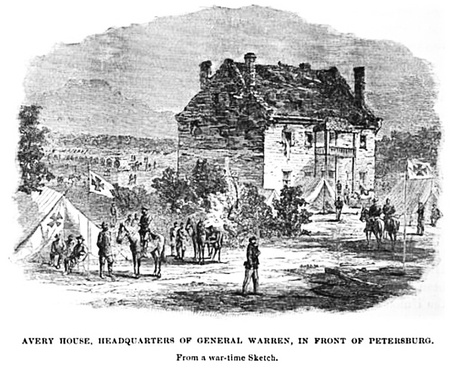 "View of the Avery House from a wartime sketch," from Coffin, Redeeming the Republic (1890), pg. 332. This is actually Globe Tavern, which was also Warren's Headquarters later in the campaign.
"View of the Avery House from a wartime sketch," from Coffin, Redeeming the Republic (1890), pg. 332. This is actually Globe Tavern, which was also Warren's Headquarters later in the campaign.
"Very gallant was the charge of Griffin’s division close by the house of Mr. Avery, near which General Warren established his headquarters. I climbed to the roof of the building, through which Confederate shells had crashed. 'Do not let them see you use your glass,' was the injunction of General Warren, who was sitting on the step of the portico. At my feet were the Union soldiers reclining on the ground; eastward, screened from the Confederates by woods, were the wagons of the Fifth Corps; westward, across the storm-swept plain, were the Confederate intrenchments, bristling with cannon and battle-flags waving above them; beyond were the spires of the city and the winding Appomattox."
-- Charles Carleton Coffin, Redeeming the Republic, pg. 333-334
"Very gallant was the charge of Griffin’s division close by the house of Mr. Avery, near which General Warren established his headquarters. I climbed to the roof of the building, through which Confederate shells had crashed. 'Do not let them see you use your glass,' was the injunction of General Warren, who was sitting on the step of the portico. At my feet were the Union soldiers reclining on the ground; eastward, screened from the Confederates by woods, were the wagons of the Fifth Corps; westward, across the storm-swept plain, were the Confederate intrenchments, bristling with cannon and battle-flags waving above them; beyond were the spires of the city and the winding Appomattox."
-- Charles Carleton Coffin, Redeeming the Republic, pg. 333-334

LC-DIG-ppmsca-53245
Notations on recto: "Hd. Qurs. 5th Army Corps June 1864 - Old Colonel Avery's house near Petersburg" and "Remembrance of the past."
Soldiers identified on mount as: Lieut. Higbee, Lt. Rickett A.D.C., Lt. Warren A.D.C., Lt. Col. Locke A.G., Lt. Col. Bankhead Insp. Genl., Capt. Marvin(?) Asst. A.G., Capt. Gentry Com. Musters, Surgeon Milhau, Capt. Smith Com. Subsistence, Captain Drum Ambulance Off., Lt. Clark Signal Off., Lt. Whaler Com'g. Escort."
 NARA 52445. General Warren and staff at the Avery House.
NARA 52445. General Warren and staff at the Avery House.
"General Warren, in directing and superintending with engineers this construction of siege operations, usually located corps headquarters close to the front, and in the vicinity of the siege works being constructed. A fine old colonial mansion, known as the Avery Mansion, situated near the Union firing line on the 18th of June, on the great charge, had been abandoned by its owners. It was, notwithstanding its continued exposed condition, taken possession of as Fifth corps headquarters, and continued to be occupied as such during the first month of the siege. It had been already damaged in actions before its spacious parlors, rooms and grounds were made corps headquarters. The latter means in active campaigning much more than the corps General and his personal staff. Headquarters comprises, in addition, a large retinue of commissioned officers, such as corps Quartermaster, corps Commissary, corps Provost Guard, corps Medical Director, a company of sharpshooters, a company of cavalry as escorts, a number of mounted and unmounted orderlies, soldier clerks, United States Military Telegraph operators. United States Signal Corps, United States mail clerks, wagoners, teamsters and colored cooks and servants, in all forming a colony of from three to four hundred people, together with horses, mules, etc., all camped close together at the end of each night march, or in winter quarters. Also the medical, hospital and ambulance officers and new men formed quite a large contingent.
It did seem unkind and even malicious in both armies during this strenuous period of the siege, that every night just as the wearied day fatigue parties and the occupants of the Corps headquarters mansion were seeking sorely-needed rest, that the Confederate and Union batteries should at intervals break out in duels lasting often an hour or more. Stray shells and spent cannon balls frequently added to the excitement by striking the old Avery Mansion, penetrating the roof or a window with a great noise, and arousing the slumberers and especially terrifying the contraband cooks and servants in the corps colony. The United States Military Telegraph Corps operators had their ticking machines on the first floor of the building destroyed by one of these unwelcome visitors. The heavy siege mortars introduced by General Warren to the grounds of the Avery Mansion, when discharged at the enemy, as was done daily, also jarred and racked the venerable mansion, adding to the discomforts of the inmates. However, but few casualties resulted from the fire of the Confederates during this period of Corps headquarters."
Source: Under the Maltese Cross: Antietam to Appomattox, Campaigns 155th Pennsylvania Regiment (Pittsburg, PA, 1910), 306-307. Contributed by Emmanuel Dabney
The Signal Corps had a hot time at the Avery house in the final months of the siege:
"Sergt. John L. Pray furnishes the following interesting sketch of life at the Avery house station (D) at this time: — Early on the 20th of March, Gen. Gordon made a close inspection of that part of the Union line now in his front, and his attention seemed to be called especially to the signal station on the Avery house, as it was somewhat conspicuous, and possibly from his standpoint was considered menacing. It is claimed that while standing near the famous 64-pound Columbiad that they had brought up to Petersburg from Fort Sumter and mounted on trucks, the general concluded that he would knock that signal party out of position, and upon his return to his headquarters issued an order to those in charge of the Columbiad to " open on that signal station and drive them out of there." Capt. J. C. Paine, signal officer at 9th Corps headquarters, had ordered inspection of men and accoutrements of all the stations attached to the Corps to take place at 1 o'clock P.M. This order included the Walthall station (A) Sergt. H. W. Holman and party; the Tree station (C), Sergt. Jordan and party; the Jerusalem plank-road station (E), Sergt. Carothers and party; and the Avery house station (D), Sergt. Horace Judson and party; also the 9th Corps headquarters party, commanded by Sergt. B. W. Marcy. The officers in charge of stations were ordered to leave one man on lookout while the party went to headquarters for inspection. While the inspection was being made the first shot from the Columbiad was directed at the Avery house. The inspection was abbreviated or supplemented with a prompt order to "return to your stations." Sergt. Judson at once took his place at the long telescope, with which he was able to almost look down the throat of the '64-pound Columbiad. His view was so plain that he was able to announce to those near him of the range, and could tell when his station was in imminent danger. Some of the shells played serious havoc about, but owing to the danger that the rebel cannoneers were placed in themselves, as our batteries were playing into them at every presentation of a man or muzzle in sight, much of their firing was random, mostly passing over the heads of the signal party. Forty-nine 64-pound projectiles were thrown over there that afternoon, forty-four of which were directed at the signal station. Five shots were aimed at a column of passing cavalry that was then going to a position on the extreme left of the Army of the Potomac. Gen. Hartranft, then commanding a division of the 9th Corps, was occupying the lower story of the Avery house, but found it untenable during this afternoon. Still further trouble was given by the Fort Sumter Seceder on the morning of the 25th, during the fighting around Fort Stedman. Quite a number of the attaches of headquarters were killed, and some of the officers' quarters were demolished. Ten days later the signal party, like all others on that ground, had the pleasure of laying their hands on the wicked monster that had been giving them so much trouble" (395-396).
The Signal Corps, U.S.A., During the War of the Rebellion. J. Willard Brown, 1896.
https://play.google.com/books/reader?printsec=frontcover&output=reader&id=MVUfAQAAMAAJ&pg=GBS.PA396
Some Operations of the Signal Corps at Petersburg
Signal Towers and Trees
“It seems almost unaccountable that greater damage was not done to some of the houses within range of the enemy's fire and without protection of works. In a residence of more than a month at the Friend house, which was in rear of Fort McGilvery and on the right of the line near the river, situated on a bluff, in range and full view of a part of the enemy's line on both sides of the river, and made prominent by a signal station in constant use on its roof, with a 13-inch mortar in position behind it, the house was not struck once, though the twice daily artillery fire sent missiles all round it. And at the Avery house, a residence of about the same length of time resulted in the same experience, although this house was less prominent. In October the enemy placed in barbette an 8-inch Columbiad directly opposite this house under the cover of darkness, but kept it there only three days, during which it was fired but once or twice. The first shell thrown from it fell directly in the door-yard in front of the house and by a piece of good fortune failed to explode.” William R. Driver, "Siege of Petersburg After the Capture of the Weldon Railroad," in Papers of the Military Historical Society of Massachusets, vol. 5 (1906), 312-313







